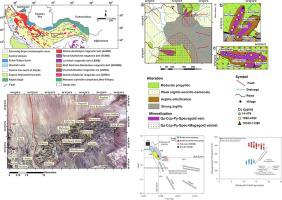当前位置:
X-MOL 学术
›
Ore Geol. Rev.
›
论文详情
Our official English website, www.x-mol.net, welcomes your feedback! (Note: you will need to create a separate account there.)
Evidence of iron oxide-copper-gold mineralization in the Torud-Chahshirin Magmatic Belt, Northern Iran: Insight from the Robaie area
Ore Geology Reviews ( IF 3.3 ) Pub Date : 2021-02-01 , DOI: 10.1016/j.oregeorev.2020.103937 Mehdi Mahdavi Akerdi , Azadeh Malekzadeh Shafaroudi , Mohammad Hassan Karimpour , Behnam Rahimi , Jose Francisco Santos
Ore Geology Reviews ( IF 3.3 ) Pub Date : 2021-02-01 , DOI: 10.1016/j.oregeorev.2020.103937 Mehdi Mahdavi Akerdi , Azadeh Malekzadeh Shafaroudi , Mohammad Hassan Karimpour , Behnam Rahimi , Jose Francisco Santos

|
Abstract The Torud-Chahshirin Magmatic Belt in northern Iran is defined by Tertiary porphyry, IOCG, Skarn, Manto, MVT, and Au, Ag and base metal-rich epithermal systems, and it is a part of the eastern Alborz Orogenic Belt of Iran. Mineralization in the Torud-Chahshirin Magmatic Belt occurs as veins, veinlet, and disseminated mineralization hosted by the Eocene-Oligocene volcanic, subvolcanic, and volcanoclastic rocks. Mineralization prospects of the Torud-Chahshirin Mgmatic Belt are spatially and temporally accompanied with magmatic rocks of early to middle Eocene (∼55-37 Ma.) calc-alkaline and early to late Oligocene (∼34-24 Ma.) alkaline rocks that have continually evolved through assimilation and fractional crystallization (AFC) processes at shallow crustal levels. The Robaie area is located in the Torud-Chahshirin Magmatic Belt. The dominant stratigraphic unit is composed of Eocene volcanic rocks (trachyandesitic to andesitic in composition), which are intruded by subvolcanic rocks. The subvolcanic rocks have features typical of shoshonitic affinity and are metaluminous to weakly peraluminous. These rocks are characterized by enrichment in large-ion-lithophile elements (LILEs) and light rare-earth-elements (LREEs), depletion of heavy rare-earth-elements (REEs, LaN/YbN ≈ 9.65 to 24.34), and high-field-strength-elements (HFSEs). Values of eNd(i) commonly show a small variation between +0.2 and +0.7, whilst 86Sr/87Sr (i) goes from 0.7056 to 0.7063. The whole set of evidence agrees with derivation of intrusive rocks of Robaie from primitive magma resulting from partial melting in a mantle wedge above a subduction zone. A sample from a dyke of biotite-hornblende diorite porphyry, with a negative eNd(i) value (-1.7), probably corresponds to a magma that underwent assimilation of crustal material. U-Pb data of zircons from dioritic stock and dyke show ages of 49.99 Ma and 50.43 Ma, respectively. Mineralization in Robaie is related to the biotite-hornblende diorite intrusions and is associated with hydrothermal alterations including argillic, argillic-silicification, argillic-sericitic, and propylitic alteration. The ore-bearing veins, veinlets, and disseminated mineralization are controlled by structures. There are two types of veins and veinlets mineralization in the Robaie area including: 1) quartz-chalcopyrite-pyrite-specularite±gold veins, and 2) quartz-chalcopyrite-pyrite-specularite-magnetite±gold veinlets. The highest amount of copper (>1%) and gold (>5 g/t) is associated with quartz-chalcopyrite-pyrite-specularite±gold veins. Microthermometric study of fluid inclusions shows that homogenization temperatures are 181 to 422 °C and salinities of ore-forming fluids ranged from 11.1 to 17 wt. % NaCl equivalent. The temperature and salinity of ore-forming fluids were lower in the formation of the quartz-chalcopyrite-pyrite-specularite±gold veins than in the quartz-chalcopyrite-pyrite-specularite-magnetite±gold veinlets, and fluid mixing was the most important mechanism for mineralization in the area. The mineralogy, alteration, geochemistry, fluid inclusion studies, and petrogenesis of subvolcanic rocks of the Robaie area indicate that the Robaie deposit could be classified as a member of the Iron Oxide-Copper-Gold (IOCG) deposits.
中文翻译:

伊朗北部 Torud-Chahshirin 岩浆带中氧化铁-铜-金矿化的证据:来自 Robaie 地区的见解
摘要 伊朗北部Torud-Chahshirin岩浆带由第三系斑岩、IOCG、Skarn、Manto、MVT以及富含Au、Ag和贱金属的浅成热液系统界定,是伊朗东部Alborz造山带的一部分。Torud-Chahshirin 岩浆带中的矿化以始新世-渐新世火山岩、次火山岩和火山碎屑岩为主的脉、细脉和浸染矿化发生。Torud-Chahshirin 镁质带的成矿前景在时空上伴随着早至中始新世 (~55-37 Ma.) 钙碱性岩浆岩和早至晚渐新世 (~34-24 Ma.) 碱性岩通过浅地壳水平的同化和分步结晶(AFC)过程不断进化。Robaie 地区位于 Torud-Chahshirin 岩浆带中。占主导地位的地层单元由始新世火山岩(成分上粗安山岩至安山岩)组成,并被次火山岩侵入。次火山岩具有典型的钾长石亲和性特征,为金属铝质至弱过铝质。这些岩石的特点是大离子亲石元素(LILEs)和轻稀土元素(LREEs)富集,重稀土元素(REEs,LaN/YbN ≈ 9.65 to 24.34)枯竭,以及高场强元件 (HFSE)。eNd(i) 的值通常显示在 +0.2 和 +0.7 之间的小变化,而 86Sr/87Sr (i) 从 0.7056 到 0.7063。整套证据与从俯冲带上方地幔楔中部分熔融产生的原始岩浆推导出罗拜侵入岩一致。来自黑云母角闪闪斑岩岩脉的样本,其 eNd(i) 值为负 (-1.7),可能对应于经历了地壳物质同化的岩浆。闪长岩和岩脉中锆石的 U-Pb 数据显示年龄分别为 49.99 Ma 和 50.43 Ma。Robaie 的矿化与黑云母-角闪闪岩侵入体有关,并与热液蚀变有关,包括泥质、泥质-硅化、泥质-绢云母质和青质岩蚀变。含矿脉、细脉和浸染矿化受构造控制。Robaie地区有两种矿脉和细脉矿化,包括:1)石英-黄铜矿-黄铁矿-镜铁矿±金脉,2)石英-黄铜矿-黄铁矿-镜铁矿-磁铁矿±金脉。铜(>1%)和金(> 5 g/t) 与石英-黄铜矿-黄铁矿-镜铁矿±金矿脉有关。流体包裹体的显微测温研究表明,均质温度为 181 至 422 °C,成矿流体的矿化度为 11.1 至 17 wt。% NaCl 等价物。石英-黄铜矿-黄铁矿-镜铁矿±金脉形成的成矿流体温度和矿化度低于石英-黄铜矿-黄铁矿-镜铁矿-磁铁矿±金脉,流体混合是最重要的机制为该地区的矿化。Robaie 地区火山岩的矿物学、蚀变、地球化学、流体包裹体研究和岩石成因表明,Robaie 矿床可归类为氧化铁-铜-金 (IOCG) 矿床的一个成员。
更新日期:2021-02-01
中文翻译:

伊朗北部 Torud-Chahshirin 岩浆带中氧化铁-铜-金矿化的证据:来自 Robaie 地区的见解
摘要 伊朗北部Torud-Chahshirin岩浆带由第三系斑岩、IOCG、Skarn、Manto、MVT以及富含Au、Ag和贱金属的浅成热液系统界定,是伊朗东部Alborz造山带的一部分。Torud-Chahshirin 岩浆带中的矿化以始新世-渐新世火山岩、次火山岩和火山碎屑岩为主的脉、细脉和浸染矿化发生。Torud-Chahshirin 镁质带的成矿前景在时空上伴随着早至中始新世 (~55-37 Ma.) 钙碱性岩浆岩和早至晚渐新世 (~34-24 Ma.) 碱性岩通过浅地壳水平的同化和分步结晶(AFC)过程不断进化。Robaie 地区位于 Torud-Chahshirin 岩浆带中。占主导地位的地层单元由始新世火山岩(成分上粗安山岩至安山岩)组成,并被次火山岩侵入。次火山岩具有典型的钾长石亲和性特征,为金属铝质至弱过铝质。这些岩石的特点是大离子亲石元素(LILEs)和轻稀土元素(LREEs)富集,重稀土元素(REEs,LaN/YbN ≈ 9.65 to 24.34)枯竭,以及高场强元件 (HFSE)。eNd(i) 的值通常显示在 +0.2 和 +0.7 之间的小变化,而 86Sr/87Sr (i) 从 0.7056 到 0.7063。整套证据与从俯冲带上方地幔楔中部分熔融产生的原始岩浆推导出罗拜侵入岩一致。来自黑云母角闪闪斑岩岩脉的样本,其 eNd(i) 值为负 (-1.7),可能对应于经历了地壳物质同化的岩浆。闪长岩和岩脉中锆石的 U-Pb 数据显示年龄分别为 49.99 Ma 和 50.43 Ma。Robaie 的矿化与黑云母-角闪闪岩侵入体有关,并与热液蚀变有关,包括泥质、泥质-硅化、泥质-绢云母质和青质岩蚀变。含矿脉、细脉和浸染矿化受构造控制。Robaie地区有两种矿脉和细脉矿化,包括:1)石英-黄铜矿-黄铁矿-镜铁矿±金脉,2)石英-黄铜矿-黄铁矿-镜铁矿-磁铁矿±金脉。铜(>1%)和金(> 5 g/t) 与石英-黄铜矿-黄铁矿-镜铁矿±金矿脉有关。流体包裹体的显微测温研究表明,均质温度为 181 至 422 °C,成矿流体的矿化度为 11.1 至 17 wt。% NaCl 等价物。石英-黄铜矿-黄铁矿-镜铁矿±金脉形成的成矿流体温度和矿化度低于石英-黄铜矿-黄铁矿-镜铁矿-磁铁矿±金脉,流体混合是最重要的机制为该地区的矿化。Robaie 地区火山岩的矿物学、蚀变、地球化学、流体包裹体研究和岩石成因表明,Robaie 矿床可归类为氧化铁-铜-金 (IOCG) 矿床的一个成员。


























 京公网安备 11010802027423号
京公网安备 11010802027423号